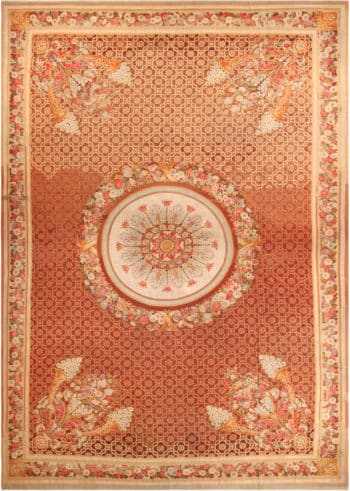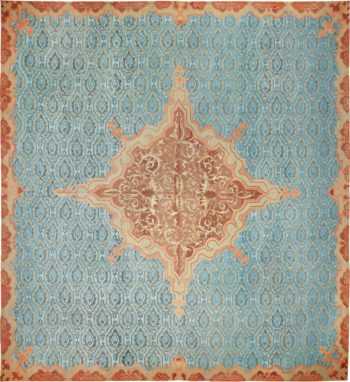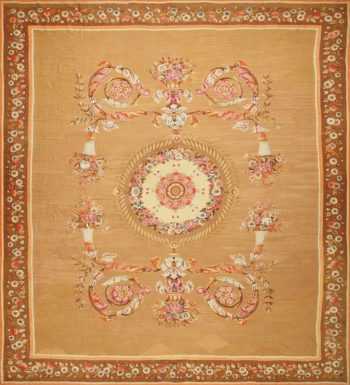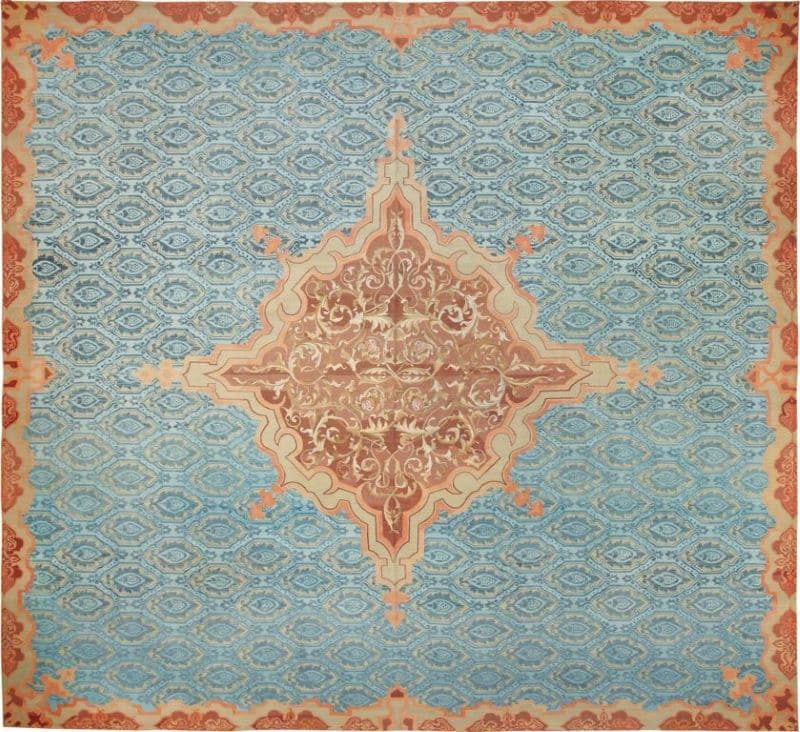French Aubusson Carpets & Rugs
Elevate Your Decor With Our Avant-Garde Collection Of Aubusson Rugs & Carpets
View our current collection of antique French Aubusson rugs:
-
Oversized Antique French Aubusson Rug 70926
$68,000.00Size: 16 ft x 26 ft 4 in (4.88 m x 8.03 m) -
Oversized 19th Century Antique French Aubusson Rug 47241
Size: 17 ft 2 in x 25 ft (5.23 m x 7.62 m) -
Large Oversized Square Antique French Aubusson Rug 50143
$44,000.00Size: 17 ft x 18 ft 5 in (5.18 m x 5.61 m) -
Antique Blue Mid 19th Century French Aubusson Carpet 49908
$46,000.00Size: 15 ft 3 in x 17 ft (4.65 m x 5.18 m) -
Large Antique French Aubusson Carpet 50430
Size: 15 ft 4 in x 16 ft 8 in (4.67 m x 5.08 m) -
Antique French Aubusson Square Floral Rug 70946
$38,000.00Size: 14 ft 8 in x 15 ft 2 in (4.47 m x 4.62 m) -
Antique Ivory French Aubusson Rug 70392
$18,500.00Size: 10 ft x 13 ft 6 in (3.05 m x 4.11 m)
Learn More About Antique French Aubusson Rugs and Carpets
What is an Aubusson style rug?
An Aubusson style rug refers to a type of rug that is inspired by the traditional tapestries and carpets produced in the French town of Aubusson. The original Aubusson rugs and tapestries have a rich history dating back to al least the 17th century. They were known for their exquisite craftsmanship and intricate designs, often depicting elaborate scenes, floral motifs, and architectural elements.
It’s worth noting that while true Aubusson rugs are handwoven in Aubusson, France, the term “Aubusson style” is often used to describe area rugs produced in other regions that emulate the distinctive aesthetic and weaving techniques of the original Aubusson rugs.
How Are Aubussons Rugs Woven?
Aubusson style rugs typically feature a flat woven construction, known as “flatweave” or “tapestry weave.” Unlike pile rugs, which have raised fibers, the French Aubusson rugs have a flat surface with no pile. They are usually made from natural fibers such as wool or silk.
What Are The French Aubusson Rug Designs?
The designs on Aubusson style rugs often include classical motifs, floral patterns, pastoral scenes, and architectural elements like columns and arches. The color palette tends to be soft and muted, with pastel tones and earthy hues being common.
The French Aubusson rug styles have been highly regarded for their elegance and timeless appeal. They are often used in more traditional and formal interior settings, such as formal living rooms, dining rooms, or grand hallways. These beautiful French area rugs can add a touch of sophistication and refinement to a space, and their intricate free flowing designs can serve as focal points or statement pieces within a room’s decor.
What makes antique French Aubusson rugs so special?
Antique French Aubusson rugs are highly regarded and considered special for several reasons:
- Artisan Craftsmanship: Aubusson rugs are known for their exceptional craftsmanship. Skilled artisans meticulously handwove these rugs using traditional techniques, resulting in high-quality, durable textiles.
- Historical Significance: Aubusson rugs have a rich history that dates back to the 17th century. Originating in the town of Aubusson in central France, these rugs were initially influenced by tapestry designs. Over the centuries, they evolved into distinct flat-woven rugs known for their elegance and sophistication.
- Elegant Design and Patterns: Aubusson rugs often feature elegant and intricate designs. They commonly incorporate classical motifs, floral patterns, and scenes inspired by nature. The designs are finely detailed, showcasing a high level of artistry and sophistication.
- Soft Color Palette: Antique Aubusson rugs typically exhibit a soft and muted color palette. The subdued tones, often featuring pastels and neutrals, contribute to a sense of timeless elegance. The restrained colors make them versatile for various interior design schemes.
- Versatility in Interior Design: Aubusson rugs complement a wide range of interior design styles. Whether used in a traditional, classic, or eclectic setting, these rugs can add a touch of refinement and sophistication to the space.
- Collectability and Rarity: Antique Aubusson rugs are highly collectible due to their historical significance, craftsmanship, and scarcity. Genuine antique pieces are often sought after by collectors and enthusiasts of fine textiles.
- Handwoven Techniques: Aubusson rugs are handwoven using flat-weave techniques, which contribute to their unique texture and appearance. The absence of a pile gives them a flat surface that works well in areas with lower foot traffic.
- Integration with Period Furniture: These rugs pair well with antique and period furniture. Their classic designs and traditional craftsmanship complement the aesthetics of vintage or antique furnishings, creating a harmonious and cohesive look.
- Artistic Expression: Aubusson rugs are considered a form of artistic expression. The weavers often adapted designs from paintings, tapestries, and other art forms, turning the rugs into functional works of art.
- Legacy of French Craftsmanship: France has a long tradition of craftsmanship and artistic production. Antique Aubusson rugs are a testament to this legacy, showcasing the skills and dedication of French artisans over the centuries.
Antique French Aubusson rugs are special due to their historical significance, artisan craftsmanship, elegant designs, and versatility in complementing various interior styles. The combination of these factors contributes to their enduring appeal and desirability in the world of antique textiles.
How do people decorate with French Aubusson rugs?
Decorating with French Aubusson rugs involves integrating these elegant textiles into your overall interior design scheme.
Here are some tips on how to effectively decorate with French Aubusson rugs:
- Select a Focal Point: Position the Aubusson rug as a focal point in the room. The intricate design and craftsmanship of these rugs make them ideal for drawing attention and anchoring the visual elements in a space.
- Coordinate Colors: Consider the color palette of the Aubusson rug and coordinate it with the overall color scheme of the room. Use the rug’s hues as a guide for selecting complementary wall colors, upholstery, and other decor elements.
- Choose Furniture Wisely: Select furniture that complements the elegance of the Aubusson rug. Antique or vintage furniture pieces often pair well with these rugs, creating a cohesive and timeless look. Consider pieces with classic lines and detailing.
- Mix with Various Styles: While Aubusson rugs have a traditional and classic appeal, they can be successfully integrated into various interior design styles. Experiment with eclectic or transitional decor to give the room a unique and personalized touch.
- Layering: Layering rugs can add depth and interest to a space. Consider placing the Aubusson rug on top of a larger, neutral rug for added texture and visual appeal.
- Create a Formal Setting: Aubusson rugs often evoke a sense of formality and sophistication. Use them in formal living rooms, dining rooms, or bedrooms to enhance the overall elegance of the space.
- Balance Patterns: If the Aubusson rug has a detailed and intricate pattern, balance it with simpler patterns in other elements of the room. This prevents the space from feeling overwhelming and allows the rug to stand out.
- Accessorize Thoughtfully: Use accessories that complement the Aubusson rug without overshadowing its beauty. Consider adding classic and refined decor items, such as mirrors, lamps, or vases, that align with the rug’s aesthetic.
- Artwork and Wall Decor: Coordinate the Aubusson rug with the artwork and wall decor in the room. Look for paintings or decorative items that share similar color schemes or design elements, creating a cohesive visual story.
- Consider Room Functionality: Keep in mind the functionality of the room. While Aubusson rugs can be used in various spaces, they may be more suitable for areas with lower foot traffic to preserve their condition over time.
By carefully coordinating colors, selecting appropriate furniture, and considering the overall aesthetic of the room, you can create a harmonious and stylish interior that showcases the beauty of a French Aubusson rug.
History of Aubusson
Aubusson is a town on the Creuse River in central France. It has been famed for its carpets as well as Tapestries since the 15th century. Antique Aubusson rugs made in tapestry technique are among the most elegant and luxurious antique floor coverings. The true date when the production of flat woven tapestry Aubusson carpets in France began is not known.
The French Aubusson Carpets and Rugs
With that said, examples of Aubusson carpets with Rococo designs have led most of us in the field to speculate that it probably began in during the mid 18th century when the taste for Oriental rugs started to shift in favor of European design. We do know that Louis the XV, Louis the XVI and Napoleon the I had all ordered flat woven Aubusson rugs (the latter two ordering far more than the former).
A 1786 inventory lists more than one hundred Aubusson carpets at the palace of Versailles and a 1789 inventory of all royal palaces describes a great many more. The fact that Aubusson rugs were easier to manufacture is the leading reason why so many rugs from this manufacturer were ordered by the aristocracy for their castles and chateaux enabling them to custom make rugs for unusually large spaces in a fraction of the time it would take to weave in pile (all the time maintaining the beauty, grace, elegance and aesthetic appeal which was demanded by the ruling class at the time). With their grand designs of frames and cartouches hung with garlands, they have a clear, Neoclassical almost architectural and soft coloration reminiscent of Greco-Roman decorative arts. These qualities still establish Aubusson rugs as one of the more effective alternatives in traditional interior decor.
French Aubusson rugs are rich in history and armed with a timeless appeal. Antique Aubusson carpets been sought after by the leading interior designers as well as consumers for decades. As a side note, the fact that these area rugs were commissioned for and by the aristocracy explains why they are far more abundant in larger sizes, more so than any other type of rug. To elaborate, Aubusson rugs are rarely found in smaller “scatter” sizes, the ruling class always desired to convey an impression of grandness, so rather than splitting up the room with a number of smaller pieces, they opted to fill the entire room, to be viewed not only as a decorative floor covering, but rather as a grand and graceful work of art to be admired by all who enter.
The aristocratic style of Aubusson rugs is like no other in France, Europe or the greater carpet-producing world. Like the most successful carpet production systems, France’s great looms were established to serve the country’s aristocratic leaders. Based on royal trends, designers painstakingly fashioned elegant flat-weave tapestry carpets that rivaled the opulent architectural style of Versailles. Using scrolling acanthus leaves and lush cabbage rose bouquets, skillful designers in Aubusson crafted elegant French carpets that perfectly complemented the baroque style of the time. The romantic pastel colors, architectural designs and floriferous style of Aubusson rugs are still appreciated by today’s top designers and celebrities. The general admiration for the lavish neoclassical style of Aubusson rugs has been continued by Coco Chanel, Tory Burch and the Kennedy’s.
French Aubusson Rugs and Carpets in Post Modern Decor
While the very idea of woven decorative floor covering is virtually synonymous with the Oriental rugs, rugs have also been produced in Europe and the Americas for centuries.
The foremost productions of this kind in Europe were the Aubusson rugs and the pile carpets of the Savonnerie manufactury of the eighteenth century, which virtually eclipsed the European taste for Oriental rugs until the 1880’s. For most of the twentieth century, however, circumstances were once again reversed.
Aubusson and Savonnerie carpets, and their English cousin – the Axminster, lived in the shadow of Oriental carpets, although they continued to maintain a certain market niche. Aubussons became the quintessential symbol of traditional European décor.
For those who still enjoyed the great period styles of Louis XV or Louis XVI, or their neo-classical successors, First and Second Empire, and English Chippendale, nothing could pull a room together more effectively than an Aubusson or a Savonnerie. Consequently, Aubusson, Savonnerie, and Axminster carpets tend to be associated with old fashioned, conservative taste.
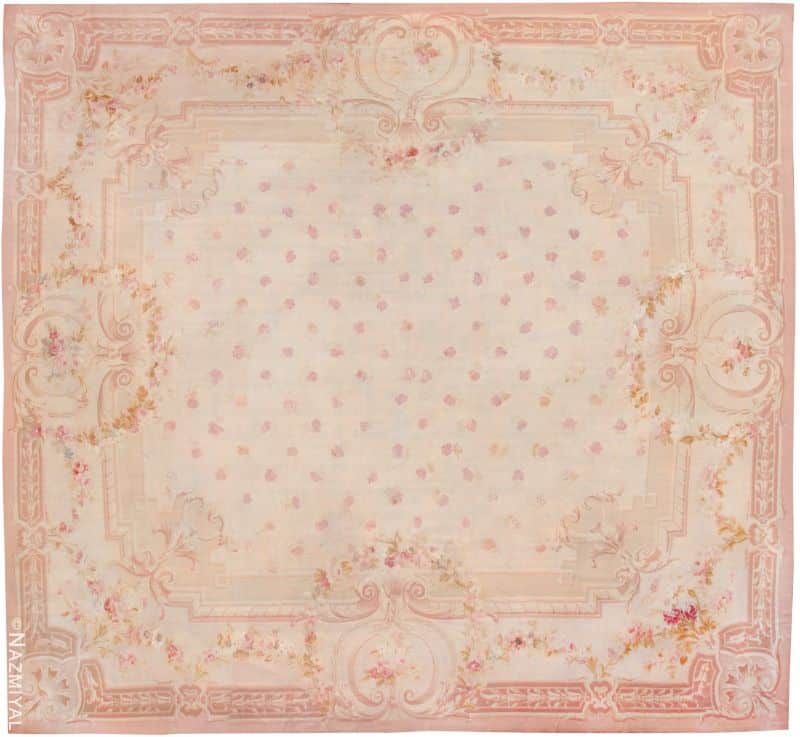
Square French Aubusson Rug (sold)
But truly great carpets, like all great works of art, transcend the immediate circumstances that created them. Oriental carpets are the product of Islamic art, yet they have long been treasured as vital components in western European interiors.
And no westerner who owns an Oriental carpet feels compelled to accompany it with Persian metal tableware and lamps or Moroccan inlaid furniture. Instead we combine antique Oriental rugs freely with western furnishings of all types, periods, and styles. So why then have Aubusson and kindred European carpets become period decorative pieces considered inseparable from some hidebound notion of neoclassical conservatism?
The answer is simply that we have come habitually to think of them that way, when in fact Aubussons are remarkably adaptive to a range of modern or contemporary uses. From the standpoint of color alone, this is eminently clear. Aubussons tend toward a dominant cream, bone, or light tan ground, with darker colors like deep tan or browns limited to outlines. Larger swaths of color are confined to cool hues such as tan, rose-magenta, or mauve.
Much of their effect is the same sort of tone-on-tone approach so cherished by contemporary interior designers. Some Aubusson carpets have monumental, almost architectural designs with grand moldings, frames, and baroque cartouches. But these qualities are always mollified or offset by the neutral, restrained palette, and the use of open, quiescent, undecorated spaces.
It is perhaps the graphic flourish of scrolls and vines in Aubussons that seems antique and old fashioned by today’s standards. Or perhaps the degree of floral or vegetative naturalism they utilize seems too lifelike for a modern sensibility focused on geometric abstraction. But modern architecture and interior design have today achieved a Post-modern aesthetic that transcends such constraining categorizations. Classicism has been deconstructed and re-examined to expose new potentials and possibilities.
Classical works or elements can be quoted and re-contextualized within a modern ambiance. Aubusson carpets no longer require Louis XVI or Empire furnishings as accompaniments. Rather, it is exciting to explore how effectively such carpets may complement a range of twentieth-century modern and contemporary styles, especially those that utilize curve-linear design elements. The results are novel and surprising, demonstrating once again how much is possible if one can simply abandon the burden of habitual opinions and preconceptions.


